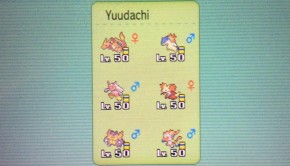Speed Kills!: Controlling and EVing Speed in VGC
“The good fighters of old first put themselves beyond the possibility of defeat, and then waited for an opportunity of defeating the enemy. To secure ourselves against defeat lies in our own hands, but the opportunity of defeating the enemy is provided by the enemy himself.”
Sun Tzu, The Art of War
In a turn-based game such as Pokémon, the person who moves first has control of the field and thus control of the battle. It is paramount, therefore, to efficiently manipulate Speed in order to make sure your Pokémon are moving first whenever possible. You can accomplish this by utilizing various methods of in-battle Speed control as well as making informed EV spreads.
Speed Control
There are several different methods of controlling Speed within a battle itself. These are six of the most common methods:
Paralysis (Thunder Wave, Glare, Body Slam, Stun Spore)
As pointed out in a previous article, Paralysis decreases a Pokémon’s Speed stat by 75%. This is arguably the most efficient method of Speed control due to its permanence (unless status healing berries, abilities, or moves are used) and Thunder Wave’s relatively wide distribution. It does have drawbacks, however. Any Ground-type or Pokémon with Volt Absorb, Motor Drive, or Lightningrod will not be affected by Thunder Wave, the most common means of inflicting Paralysis. In addition, Pokémon with the Guts or Quick Feet ability almost welcome Paralysis due to the fact that their Attack or Speed, respectively, become boosted by status effects (though they still have to deal with the 25% chance of being fully Paralyzed). The same goes for teams that utilize Trick Room, as their Speed is effectively “boosted” under the effect of Trick Room.
Spread Speed Reducing Moves (Icy Wind, Bulldoze, Electroweb)
Each of these moves hits both enemies (and in the case of Bulldoze, your partner as well) and reduces their speed by one stage for each use of the move. A one stage reduction in Speed will decrease a Pokémon’s speed by 33%, while a two-stage drop will decrease it by 50% and a three-stage drop by 60%. This strategy is efficient, but it does have its drawbacks: an afflicted Pokémon can switch out to negate the Speed drop, and Pokémon with Clear Body such as Metagross do not receive any reduction in stats from these moves. Defiant or Contrary users do not care as much about these moves, either, since they will get a boost in stats as a result of getting hit with the moves. Wide Guard completely blocks these moves, allowing a partner to attack you while you try to set up a Speed drop.
Trick Room
The most involved method of Speed control, this move reverses the order of Pokemon movement in each priority bracket for a duration of 5 turns after the move is used. Therefore, the Pokémon with the lowest Speed stat will move first in each priority bracket, while the Pokémon with the highest Speed stat will move last. This allows slow but powerful Pokémon such as Conkeldurr to wreak havoc on opponents, but Trick Room can be shut down by Taunt users or, due to the move’s extremely low priority, by just killing the Pokémon trying to use the move before they can get it off. Without another form of Speed control, this will leave the slower Pokémon suited to a Trick Room team very vulnerable. Trick Room setters are also a bit predictable, and can be easily scouted at the Pokémon selecting screen. Be aware as well that priority stays the same, so a Scizor (at base 65 Speed) using Bullet Punch will still attack before an Amoonguss (base 30) using Spore.
Speed modifying items (Choice Scarf, Iron Ball, Power Items)
Choice Scarf increases the holding Pokémon’s Speed stat by 50% while locking it into using the same move for however long it is on the field of battle. This is most often utilized to gain a surprise kill with a powerful, mid-Speed Pokémon. Its use necessitates switching, however, and once the Skitty is out of the proverbial bag, a Scarfed Pokémon is somewhat easy to predict around. Iron Ball and each of the Power items (including the Macho Brace) each decrease the holding Pokémon’s Speed stat by 50%, which may be helpful for Trick Room or setting weather (more on that below). The obvious drawback is that when not under the effects of Trick Room, these items highly increase the likelihood that you’ll be going last. This can be mitigated by using a Pokémon with Trick or another such move, however, as the move can foist this disadvantage onto your opponent and act as another form of permanent Speed control.
Speed increasing abilities (Swift Swim, Chlorophyll, Sand Rush, Motor Drive, Speed Boost, Quick Feet, Steadfast, Unburden, Rattled, Weak Armor)
The first three abilities double a Pokémon’s Speed while under the effects of Rain, Bright Sunlight, or Sandstorm, respectively. This strategy of Speed control is neutralized by changing the weather to one less favorable, or by utilizing one of the other methods of Speed control (especially Paralysis or Trick Room). The others will increase your Pokémon’sSpeed stat by either one or two stages (depending on the ability) once certain criteria are met, like being attacked by an Electric-type attack (Motor Drive), being afflicted with status (Quick Feet) or being flinched (Steadfast). In all cases these boosts will be lost by switching out.
Tailwind
Doubles the Speed of all Pokémon on the user’s side of the field for 3 turns after it is used. This is handy in that it affects all Pokémon on your side of the field, allowing a support Pokémon to set it up while a slower sweeper takes advantage of it. Unlike Trick Room, Tailwind has normal priority, meaning that it is easier to get off. However, it is still limited in that it effectively only lasts 3 turns and Trick Room or Paralysis can shut it down.
Utilizing Speed Control
A good team typically has two or three different Pokémon that can utilize one of these methods, with many players opting to use more than one method in conjunction with another. It’s common to run Thunder Wave and Icy Wind on the same team, due to the synergy the two moves have. Other teams may utilize several Pokémon using the same method of Speed control. Trainers using a dedicated Trick Room or Rain team, for example, are likely to have multiple Pokémon with Trick Room or Swift Swim, respectively.
There are other methods of Speed control not listed here: single-target Speed reducing moves such as Cotton Spore and Low Sweep; self-targeting Speed modifying moves such as Dragon Dance, Quiver Dance, and Curse; turn-altering moves such as After You and Quash; and increased priority moves such as Bullet Punch and Mach Punch. For the most part, these suffer problems with inefficiency, low distribution, or some combination of the two, but there may be niches where you may choose to use them. Priority in particular could be worth looking at, but keep in mind that these moves are generally low-powered.
Identifying threats and Speed creeping accordingly
Now that we know how we’re going to control Speed in our battles, we can move on to EVs and Natures. In essence, in order to determine which Speed you want to hit, you have to consider the following questions:
What Speed can my Pokémon possibly hit?
This is determined by base stats, Nature, and IV. Most online Pokedexes have information on what Speeds are possible for various Pokémon. I personally use the Pokemon Online editor, as I can adjust for Nature and IVs to see what Speeds I can hit, and it allows me to see exactly how many EVs I need to hit a certain Speed stat once I know what target I want to reach.
What threats can I outspeed, given these limitations?
Knowing what you want to be able to kill ahead of time is paramount. It makes no sense to blindly max Speed if you can still outspeed an important threat with less EVs. These extra EVs can be transferred to other stats, adding bulk or offensive power that could come in handy. Knowing what threats to examine requires a bit of foreknowledge about the metagame, but a good place to look is on the Pokémon GBU website, which has a list of the 10 most commonly used Pokémon in each battle format as well as information on which Pokémon are commonly used alongside them. Another decent source of numbers to hit for certain threats can be found here.
A corollary to this question is, “If I can outspeed a threat, should I?” There may be times when it makes sense to sacrifice the ability to outspeed an opponent in exchange for greater bulk or attacking power. Metagross is a good example of this. With a boosting nature, it is able to outspeed max Speed neutral base 80 Pokémon such as Mamoswine, Chandelure, and Dragonite. Since it’s able to hit these Pokémon super effectively (and is likely hit super effectively right back), it may make sense to try out outspeed these threats. However, Metagross loses a lot of attacking power by not running an Attack-boosting Nature, and even with a Speed-boosting Nature it still requires 244 EVs to outspeed these threats. This means sacrificing more Attack or bulk, which limits Metagross’ effectiveness somewhat. Unless you’re running a Choice Band set, it usually makes more sense to run a bulkier Metagross with a lower Speed.
With the tools at my disposal, can I overcome these Speed limitations and still outspeed certain threats?
If there is a threat at a higher Speed that you absolutely want to be able to kill, consider the methods of Speed control outlined earlier in the article. Keep in mind the drawbacks of each method, as well as the fact that you will likely need to run a Speed that works both with and without the method to be effective. In the rain, Swift Swim Ludicolo requires only 84 Speed EVs with a neutral nature to outspeed anything that isn’t Scarfed (bar Accelgor). However, should you decide you want to outspeed 4 Speed neutral Suicune and Cresselia outside of the rain, you’d need to raise that value to 132 Speed EVs. You will still accomplish your first goal, and now you will be able to outspeed a threat when your method of Speed Control isn’t working.
Another thing to keep in mind is that your opponent will also be using these same methods of Speed control to try to influence the match in their favor. You may want include a Pokémon or EV spread on your team that will mitigate the opponent’s use of different Speed control methods, such as using a Lightningrod Pokémon to deal with Thunder Wave or a slow, bulky Pokémon like Amoonguss or Ferrothorn to help deal with Trick Room.
Are there any special situations where I would benefit from running a specific Speed?
Weather setters (such as Tyranitar, Politoed, and Abomasnow) have a unique problem when it comes to figuring out what Speed to run. If two Pokémon that set different types of weather are sent out at the same time, the slower Pokémon’s Ability will take precedence. For example, normally Tyranitar is faster than Abomasnow. If you want to ensure that Tyranitar gets Sand up rather than Abomasnow’s Hail, you can run a Speed-limiting Nature and an IV of 0. This will make Tyranitar slower than any Abomasnow that is not doing the same thing, and thus ensures that in the event of the two Pokémon coming out at the same time, Tyranitar will always get Sand up. Another way to help ensure this is to use an Iron Ball (or Power item), which decreases the holder’s Speed by 50%. In this case, Tyranitar can run up to 114 Speed (which requires a Jolly Nature to hit) and still be slower than any Abomasnow not holding an Iron Ball itself.
There may be other situations where you have other influences on what Speed you’ll run. A great example of this is Duy’s San Jose Regional team, which featured a Trick Room Cresselia running with a Speed stat of 81. He chose to invest just enough Speed EVs in his Machamp to reach 82 Speed, which ensured that Cresselia would always go before Machamp under Trick Room and thus give a Swagger boost to Machamp before it attacked. This is a common tactic on teams built around the use of Trick Room and Swagger.
One other situation to keep in mind is if you happen to know what your opponent is likely to run and you wish to counter-team them. For example, if you happen to know that your opponent runs the same Dragon Gem Hydreigon Ray Rizzo used at Worlds 2012, you can run your own Hydreigon with 8 more Speed EVs than Ray’s to ensure that you’ll go first. This is known as “Speed Creep”.
Building an EV spread
With those questions in mind, let’s try looking at an example. Say that your team is weak to Garchomp, which maxes out at 169 Speed when Jolly. You have two Pokémon on your team that are potentially capable of dealing with this threat: Ice Punch Weavile and HP Ice Heatran. How can we ensure that our Pokémon will go first and get the KO before Garchomp can strike us down?
Getting Weavile to outspeed Garchomp is easy enough. Weavile has a higher base Speed than Garchomp, and is so fast that it can in fact outspeed Garchomp with a neutral nature. With an Adamant nature, Weavile only needs 196 Speed EVs to outspeed every Garchomp your opponent could use against you (with the exception of Choice Scarf varieties). This gives you 314 EVs to allocate into different stats, whereas if you’d maxed your Speed, you’d only have 256 EVs to work with.
Heatran, on the other hand, has its work cut out for it. Even if you ran a boosting nature such as Timid, you could only hit a maximum Speed of 141. Even an Adamant Garchomp can outspeed that with plenty of EVs left over. However, your team also features Icy Wind Cresselia. After an Icy Wind, any non-Scarfed Garchomp will have at most 112 Speed. This is much easier to deal with, and indeed, with a Modest nature and 124 EVs, your Heatran will outspeed any non-Scarfed Garchomp after a single Icy Wind.
Conclusion
Effectively utilizing different methods of Speed control and EV training your Pokémon with them in mind will allow you to achieve greater results in your battles. Knowing that you’ll outspeed certain threats ahead of time allows you to deal with those threats that much more efficiently, allowing you to utilize your own strategies with greater success. You’ll be able to go into a battle knowing that it’s yours to win or lose, rather than up to your opponent or the whims of the RNG, and that knowledge is one of the most important things a trainer can have.
Article image created by feathers for Nugget Bridge. View more of her artwork on her tumblr or Nugget Bridge forums thread.










